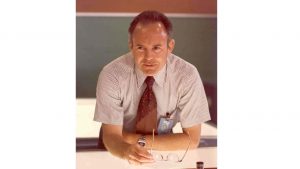Computer Industry Mourns Death of Intel Co-Founder Gordon Moore
Moore’s Law famously predicted the number of transistors on a circuit would double every two years.
March 27, 2023

IT leaders offered tributes to Intel co-founder Gordon Moore, who died on Friday at his home in Hawaii. Moore, Intel’s longest-serving chairman and CEO, is credited with commercializing PCs and laptop computers.

Gordon Moore/Courtesy: Intel Corporation
Nevertheless, Moore’s Law set the pace of change in the industry for decades. Moore famously predicted in 1965 that the number of transistors on a circuit would double yearly. In 1975, Moore revised that prediction to every two years.
“For over 40 years, Intel engineers have continually innovated to squeeze more and more transistors onto ever-smaller chips and maintain the pace of Moore’s Law,” Intel executive VP and general manager of technology development Ann Kelleher wrote last year.
Moore co-founded Intel with Robert Noyce in 1968. According to his obituary posted by Intel, Moore began his career conducting research at Johns Hopkins Applied Physics Laboratory. In 1956, Moore joined Shockley Semiconductor, and a year later, Noyce and six other Shockley colleagues co-founded Fairchild Semiconductor. Eleven years later, Moore and Noyce co-founded Intel.

Intel’s Pat Gelsinger
“He was instrumental in revealing the power of transistors and inspired technologists and entrepreneurs across the decades,” Intel CEO Pat Gelsinger said in a statement. “We at Intel remain inspired by Moore’s Law and intend to pursue it until the periodic table is exhausted.”
A ‘Giant’ in the Computer World
Tributes to Moore poured in on social media over the weekend. Industry analyst Tim Bajarin, founder and president of Creative Strategies, posted on Facebook: “He was a giant in the semiconductor and computer world and leaves behind an amazing legacy.”
On Sunday, IBM chairman and CEO Arvind Krishna recalled in a post on Twitter Moore’s impact on computing. “Today, all of IBM is celebrating the remarkable life of Gordon Moore, the self-described ‘accidental entrepreneur’ whose $500 investment in the nascent microchip industry helped build both the digital world we know — and the one that’s still on the horizon” Krishna wrote.
Many who knew Moore and those who followed his work also weighed in on Twitter throughout the weekend. Ethan Mollick, an associate professor at the Wharton School of the University of Pennsylvania, shared in a post that he wrote his first academic paper on Moore’s Law. “He was right,” Molick noted. “And led to our accelerating world.”
Responding to Mollick was Ryan Shaw, a software developer, who shared that he was born in the early 1980s. “I’ve been using personal computers since I was a kid, and I work as a software dev,” he noted. “Moore’s Law is the story of my life.”
Sutter Hill Ventures managing director Sam Pullara recalled: “I once got the opportunity to ask Gordon Moore a question, ‘What is the equivalent of Moore’s Law for software?’ His response, ‘number of bugs doubles every year.’ Great man.”
Industry colleagues also recalled Moore’s legacy. Lisa Su, CEO of Intel’s largest rival, AMD, shared her respect for Moore. “Gordon Moore and ‘Moore’s Law’ inspired all of us as students, engineers, and leaders in the semiconductor industry,” Su noted. ��“He was a true visionary and deeply admired.”
Former AWS and IBM channel executive Sandy Carter agreed. “Gordon Moore’s predictions in 1965 about the exponential growth of computing power have stood the test of time,” she wrote. “And I honor his life as his insights continue to drive innovation and progress in the tech industry.”
Gordon Moore Life Timeline
1950: Moore earned his bachelor’s degree in chemistry from University of California at Berkeley. Later that year, Moore married Betty Irene Whitaker. In 1954 he received his Ph.D. in chemistry from the California Institute of Technology.
1956: Moore joined Shockley Semiconductor but left the next year with Robert Noyce to form Fairchild Semiconductor.
1965 Moore’s Law, which predicted the future of electronics, in which the number of transistors on a circuit would double every year, is published. A decade later he would revise that to every two years.
1968: Moore and Noyce co-founded Intel launches the company’s first product, the first functional 64-bit random access memory a year later. In 1971 Intel launched Intel4004, the first microprocessor. In 1975, Intel named Moore president, and added the CEO title in 1978, and chairman in 1979, which he held until 1987. Andy Grove succeeds Moore as CEO.
2002 U.S. President George W. Bush awards Moore with the Presidential Medal of Freedom award.
2022 Ronler Acres campus in Oregon gets a new name — Gordon Moore Park at Ronler Acres
Want to contact the author directly about this story? Have ideas for a follow-up article? Email Jeffrey Schwartz or connect with him on LinkedIn. |
Read more about:
VARs/SIsAbout the Author
You May Also Like


